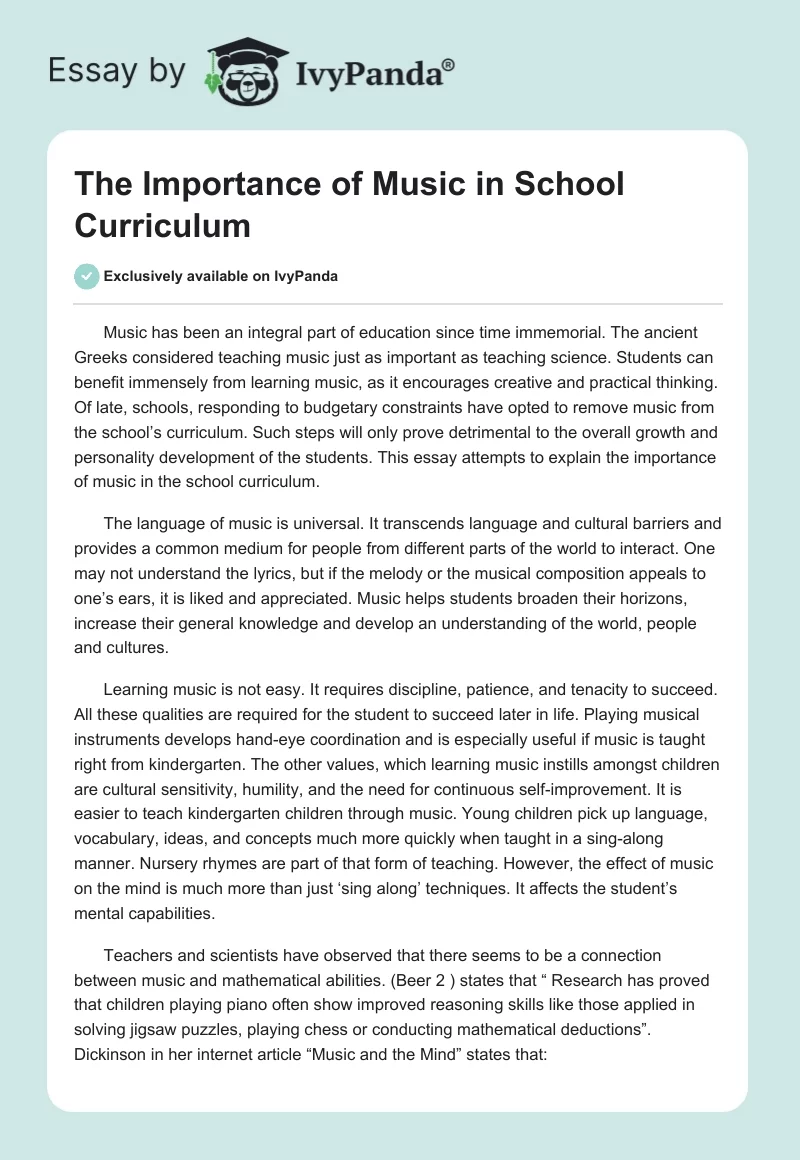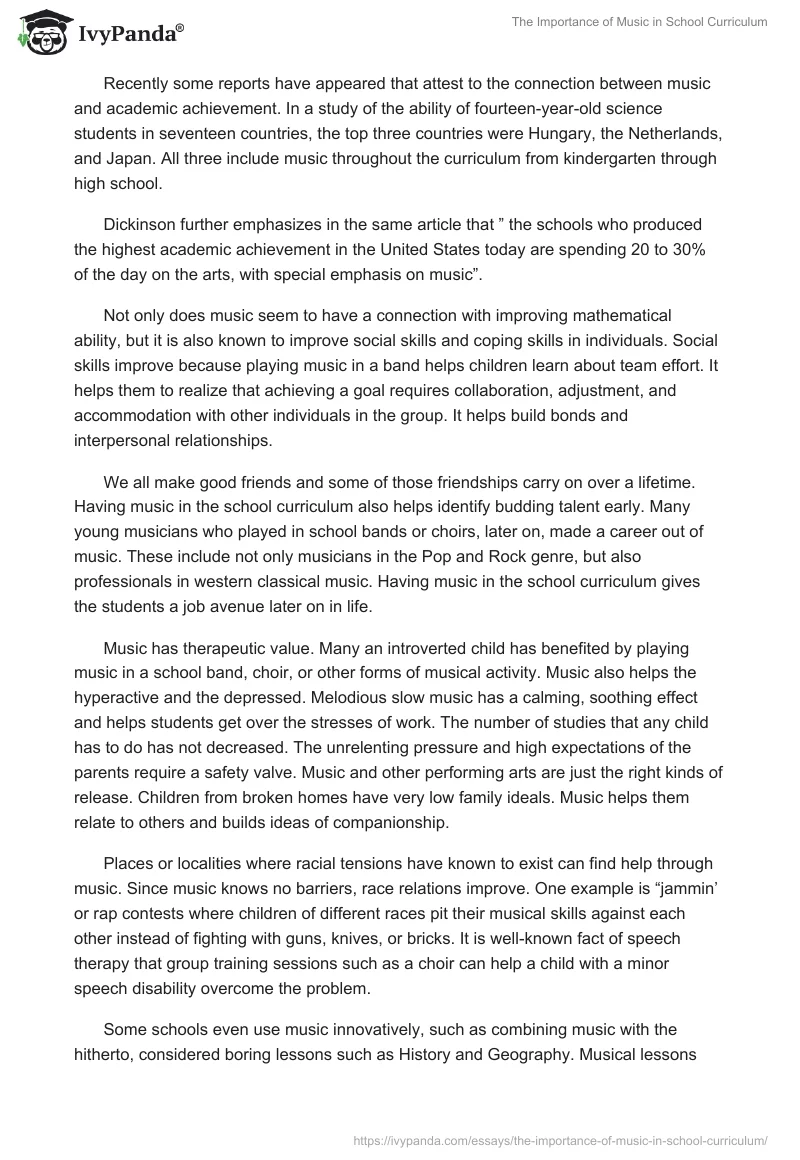Music has been an integral part of education since time immemorial. The ancient Greeks considered teaching music just as important as teaching science. Students can benefit immensely from learning music, as it encourages creative and practical thinking. Of late, schools, responding to budgetary constraints have opted to remove music from the school’s curriculum. Such steps will only prove detrimental to the overall growth and personality development of the students. This essay attempts to explain the importance of music in the school curriculum.
The language of music is universal. It transcends language and cultural barriers and provides a common medium for people from different parts of the world to interact. One may not understand the lyrics, but if the melody or the musical composition appeals to one’s ears, it is liked and appreciated. Music helps students broaden their horizons, increase their general knowledge and develop an understanding of the world, people and cultures.
Learning music is not easy. It requires discipline, patience, and tenacity to succeed. All these qualities are required for the student to succeed later in life. Playing musical instruments develops hand-eye coordination and is especially useful if music is taught right from kindergarten. The other values, which learning music instills amongst children are cultural sensitivity, humility, and the need for continuous self-improvement. It is easier to teach kindergarten children through music. Young children pick up language, vocabulary, ideas, and concepts much more quickly when taught in a sing-along manner. Nursery rhymes are part of that form of teaching. However, the effect of music on the mind is much more than just ‘sing along’ techniques. It affects the student’s mental capabilities.
Teachers and scientists have observed that there seems to be a connection between music and mathematical abilities. (Beer 2 ) states that “ Research has proved that children playing piano often show improved reasoning skills like those applied in solving jigsaw puzzles, playing chess or conducting mathematical deductions”. Dickinson in her internet article “Music and the Mind” states that:
Recently some reports have appeared that attest to the connection between music and academic achievement. In a study of the ability of fourteen-year-old science students in seventeen countries, the top three countries were Hungary, the Netherlands, and Japan. All three include music throughout the curriculum from kindergarten through high school.
Dickinson further emphasizes in the same article that ” the schools who produced the highest academic achievement in the United States today are spending 20 to 30% of the day on the arts, with special emphasis on music”.
Not only does music seem to have a connection with improving mathematical ability, but it is also known to improve social skills and coping skills in individuals. Social skills improve because playing music in a band helps children learn about team effort. It helps them to realize that achieving a goal requires collaboration, adjustment, and accommodation with other individuals in the group. It helps build bonds and interpersonal relationships.
We all make good friends and some of those friendships carry on over a lifetime. Having music in the school curriculum also helps identify budding talent early. Many young musicians who played in school bands or choirs, later on, made a career out of music. These include not only musicians in the Pop and Rock genre, but also professionals in western classical music. Having music in the school curriculum gives the students a job avenue later on in life.
Music has therapeutic value. Many an introverted child has benefited by playing music in a school band, choir, or other forms of musical activity. Music also helps the hyperactive and the depressed. Melodious slow music has a calming, soothing effect and helps students get over the stresses of work. The number of studies that any child has to do has not decreased. The unrelenting pressure and high expectations of the parents require a safety valve. Music and other performing arts are just the right kinds of release. Children from broken homes have very low family ideals. Music helps them relate to others and builds ideas of companionship.
Places or localities where racial tensions have known to exist can find help through music. Since music knows no barriers, race relations improve. One example is “jammin’ or rap contests where children of different races pit their musical skills against each other instead of fighting with guns, knives, or bricks. It is well-known fact of speech therapy that group training sessions such as a choir can help a child with a minor speech disability overcome the problem.
Some schools even use music innovatively, such as combining music with the hitherto, considered boring lessons such as History and Geography. Musical lessons are easier to assimilate; after all, lyrics of favorite songs are easily remembered without really trying hard. The importance of music in special schools is even more accentuated as the therapeutic effect of music helps calm down special children.
Music also has an important role to play in strengthening religious beliefs and anchoring children’s faith in god. While in the United States, every citizen is free to practice their religion or even deny the existence of God, religious music and Sunday church choirs have an undeniable part to play in the overall development of a child. According to (Yount 2), “the study of the history of music (and particularly the music of the Christian era) can enhance our cultural identity as Christians”.
Schools and institutions have all understood the importance of music in a child’s development. Some bodies have even gone public to encourage schools to continue keeping music in their curriculum. The National Association of Elementary School Principals (NAESP), on its website, states that “Providing an environment of acceptance for all students through music—even for one hour per day—is a first step toward connecting with students from all backgrounds and helping them to develop healthy life skills”. In the US, they are a powerful body that can influence authorities and school boards to desist from removing music out of the school curriculum and have made a significant contribution in making many a school changes their minds.
Music, therefore, plays an important role in the overall development of the students. Music helps young children learn vocabulary faster, has been shown to increase mathematical ability amongst those students who practice music, and has proved to be a useful team-building tool. Music helps students understand the world better. It helps them develop values such as hard work, patience, tenacity, humility, and self-discipline. Music is a stress buster and has a great therapeutic effect.
Schools that have persisted with music in their curriculum have shown better academic results. The introduction of music in the school curriculum has helped identify many a budding ‘Mozart’ thus helping students progress a musical career. Music in schools has helped bring down juvenile delinquencies by providing the students a medium to forget their differences and band together. The conclusion, therefore, is that music must continue to form part of every school’s curriculum and not be made a victim to budgetary constraints.
Works Cited
Beer, Michael. “How do Mathematics and Music Relate to Each Other”. 1998. Home page. Drexel University. Web.
Dickinson, Dee. “ Music and the Mind”. 1993. New Horizons. Web.
NAESP Website. “The Importance of Music Education in the Middle School Curriculum”. 2007. NAESP. Web.
Yount, Laura A. “The Importance of Music in the Christian Classical Curriculum”. 2004. Web.


